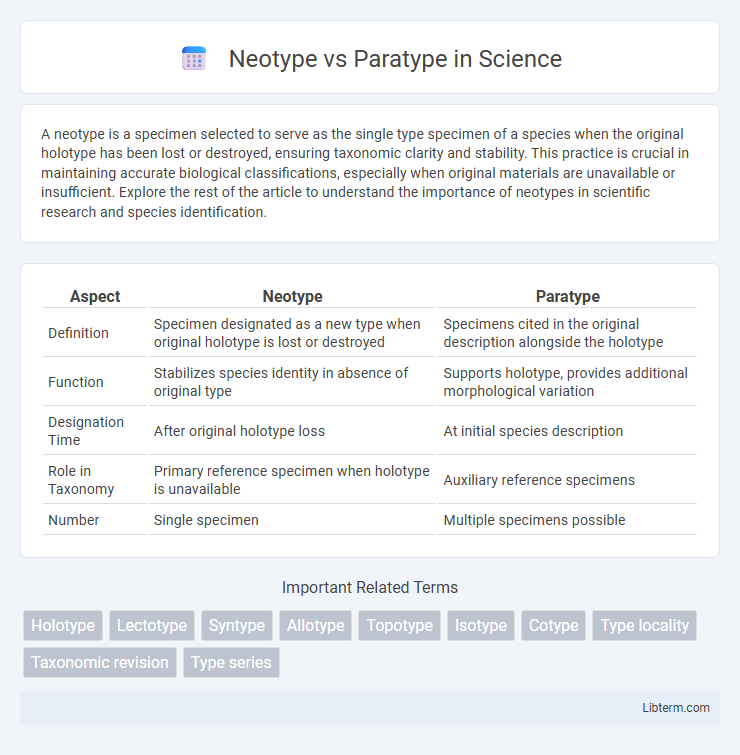A neotype is a specimen selected to serve as the single type specimen of a species when the original holotype has been lost or destroyed, ensuring taxonomic clarity and stability. This practice is crucial in maintaining accurate biological classifications, especially when original materials are unavailable or insufficient. Explore the rest of the article to understand the importance of neotypes in scientific research and species identification.
Table of Comparison
| Aspect | Neotype | Paratype |
|---|---|---|
| Definition | Specimen designated as a new type when original holotype is lost or destroyed | Specimens cited in the original description alongside the holotype |
| Function | Stabilizes species identity in absence of original type | Supports holotype, provides additional morphological variation |
| Designation Time | After original holotype loss | At initial species description |
| Role in Taxonomy | Primary reference specimen when holotype is unavailable | Auxiliary reference specimens |
| Number | Single specimen | Multiple specimens possible |
Introduction to Taxonomic Types
Neotypes serve as replacement specimens when original holotypes or syntypes are lost or destroyed, ensuring stability in species identification. Paratypes are additional specimens cited in the original description that support the holotype and provide variation context within the species. Both are critical in taxonomic nomenclature, enhancing precision and reproducibility in species classification.
Definition of Neotype
A neotype is a specimen selected to serve as the single type specimen when the original holotype and all other original material are lost or destroyed, providing a new reference point for the species' identity. Paratypes are specimens cited in the original description that supplement the holotype but do not serve as the primary reference. The designation of a neotype ensures taxonomic stability by replacing missing type material while paratypes help illustrate variability within the species.
Definition of Paratype
A paratype is a specimen cited in the original description of a species that shows additional variation but is not the primary type specimen, known as the holotype. Paratypes provide supplementary morphological data supporting the species' diagnostic features and aid in understanding intraspecific variation. Unlike neotypes, which are designated later when no original type exists, paratypes are part of the original type series.
Importance of Type Specimens in Taxonomy
Type specimens such as neotypes and paratypes serve as essential reference points for accurate species identification and classification in taxonomy. A neotype is designated when the original holotype is lost or destroyed, providing a new standard for a species name, while paratypes are supplementary specimens cited alongside the holotype to demonstrate variation within a species. These specimens ensure taxonomic stability and consistency by anchoring species names to concrete, physical examples, facilitating reliable communication in biological research.
Criteria for Designating a Neotype
A neotype is designated when the original holotype or all original material are lost or destroyed, ensuring stability in taxonomic identification. The criteria for selecting a neotype include its conformity with the original description, availability of comparable specimens, and preservation from the type locality or a nearby area. Unlike paratypes, which are part of the original type series and support the holotype, neotypes specifically replace lost type material to maintain nomenclatural clarity.
Role and Selection of Paratypes
Paratypes serve as supplementary specimens in taxonomy, supporting the holotype by illustrating the range of variation within a species, whereas a neotype is designated only when the original holotype is lost or unavailable. The selection of paratypes involves choosing additional specimens from the original type series that exhibit key characteristics and variability, aiding in defining the species' diagnostic traits. Paratypes do not hold primary nomenclatural status but are crucial in validating and refining species descriptions alongside the holotype or neotype.
Differences Between Neotype and Paratype
Neotype is a specimen selected to serve as the type specimen when the original holotype has been lost or destroyed, whereas paratype refers to any specimen from the original type series other than the holotype. Neotypes provide a new primary reference for species identification under strict conditions governed by the International Code of Zoological Nomenclature, while paratypes serve as supplementary reference material supporting the holotype's characterization. The key difference lies in their roles: neotypes replace missing primary types, while paratypes complement the holotype without replacing it.
Legal and Ethical Considerations
Neotypes serve as replacement type specimens designated when original holotypes are lost or destroyed, with strict legal protocols ensuring their selection respects the International Code of Zoological Nomenclature to preserve taxonomic stability. Paratypes, as supplementary specimens associated with the holotype, require ethical considerations for collection, emphasizing adherence to conservation laws and minimizing impact on wild populations. Legal frameworks govern the acquisition, preservation, and documentation of both neotypes and paratypes to ensure scientific integrity and protect biodiversity rights.
Case Studies: Neotype and Paratype Examples
Neotype and paratype specimens serve distinct roles in taxonomic classification, with neotypes designated to replace lost or inadequate holotypes while paratypes accompany the holotype to provide additional morphological context. Case studies reveal that neotypes are often selected in critical taxonomic revisions when original types are missing, as in the reclassification of certain butterfly species in the genus Papilio. Paratype examples highlight their use in describing intraspecific variation, such as the multiple paratypes cited in the original description of the dinosaur species Velociraptor mongoliensis to capture morphological diversity within the species.
Conclusion: Choosing the Right Type Specimen
Selecting the appropriate type specimen between a neotype and a paratype depends on the availability and condition of original material; neotypes are designated when original holotypes are lost or inadequate, serving as a new reference for species identity. Paratypes, conversely, are supplementary specimens that support the holotype during initial species description, providing variation context but not replacing the primary type. Accurate taxonomic decisions hinge on understanding these roles, ensuring precise species identification and nomenclatural stability.
Neotype Infographic

 libterm.com
libterm.com